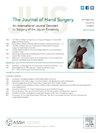Adjunctive Dorsal Spanning Plate Fixation in the Stabilization of Perilunate Dislocations
IF 2.1
2区 医学
Q2 ORTHOPEDICS
引用次数: 0
Abstract
Purpose
To compare the biomechanical properties of adjunctive dorsal spanning plate (DSP) fixation with traditional K-wire fixation of perilunate dislocations in a cadaveric model.
Methods
Fourteen fresh-frozen cadaveric wrists underwent simulated perilunate injury. The specimens were randomly allocated to either K-wire fixation versus K-wire and DSP fixation. Scapholunate (SL) ligament repair was performed in all specimens. The constructs were tested using a robot cyclically and to failure. Fluoroscopic images were obtained of the specimens prior to simulated injury, after fixation, after 10 and 100 loading cycles, and at construct failure. Differences in carpal alignment parameters (SL interval, SL angle, lunotriquetral interval, and capitolunate angle) and load to failure were recorded.
Results
There were no statistically significant differences between the two group’s carpal alignment parameters after fixation. Specimens fixated with K-wires and DSP required significantly higher loads to achieve construct failure. The only significant difference between the two groups’ carpal alignment parameters was SL interval change at failure.
Conclusions
Compared with K-wire fixation alone, adjunctive DSP fixation resulted in significantly increased loads to failure and decreased change in SL interval at the time of failure.
Clinical relevance
Adjunctive DSP may be a useful technique in the polytraumatized patient in whom providing back a weight-bearing extremity may be advantageous in the rehabilitation process.
在稳定趾骨周围脱位中辅助背侧棘板固定术
目的:在尸体模型中比较背跨板(DSP)辅助固定与传统 K 线固定治疗腕关节周围脱位的生物力学特性:方法:对 14 具新近冷冻的尸体手腕进行模拟腕关节周围损伤。这些标本被随机分配为 K 线固定与 K 线和 DSP 固定。所有标本都进行了肩胛韧带(SL)修复。使用机器人对构建物进行了周期性和失效测试。在模拟损伤前、固定后、10 个和 100 个加载周期后以及结构失效时,对标本进行透视成像。记录了腕关节排列参数(SL间距、SL角度、月曲腕间距和Capitolunate角度)和加载至破坏时的差异:结果:固定后,两组患者的腕关节排列参数差异无统计学意义。使用 K 线和 DSP 固定的标本需要更高的载荷才能达到结构失效。两组腕关节对齐参数的唯一显著差异是失败时的SL间隔变化:结论:与单独使用 K 线固定相比,辅助 DSP 固定导致的破坏载荷明显增加,而破坏时 SL 间距的变化则有所减少:临床相关性:对于多发性创伤患者来说,辅助 DSP 可能是一种有用的技术,在康复过程中,为患者提供一个负重肢体可能是有利的。
本文章由计算机程序翻译,如有差异,请以英文原文为准。
求助全文
约1分钟内获得全文
求助全文
来源期刊
CiteScore
3.20
自引率
10.50%
发文量
402
审稿时长
12 weeks
期刊介绍:
The Journal of Hand Surgery publishes original, peer-reviewed articles related to the pathophysiology, diagnosis, and treatment of diseases and conditions of the upper extremity; these include both clinical and basic science studies, along with case reports. Special features include Review Articles (including Current Concepts and The Hand Surgery Landscape), Reviews of Books and Media, and Letters to the Editor.

 求助内容:
求助内容: 应助结果提醒方式:
应助结果提醒方式:


